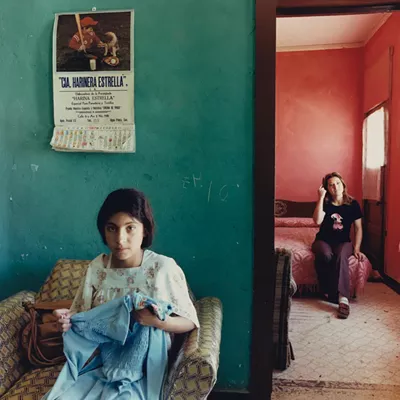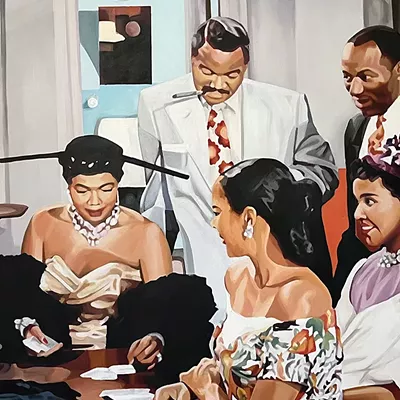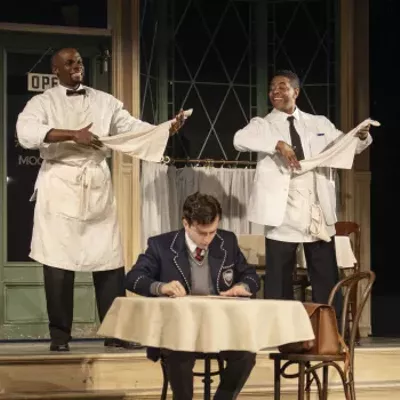"When I heard they were going to demolish Tucson General Hospital, I couldn't stand it," she said last week, in her office in the UA's School of Architecture, referring to the 1963 building by architect Arthur Brown. "I had to do something."
What she did was jump-start a new nonprofit called the Modern Architecture Preservation Project, enlisting fellow architects who had been active in the preservation of modern architecture.
Not that MAPP's new members have always been successful. Buildings from the heyday of mid-century modernism--roughly 1945 to 1975--are nowadays at high risk of a date with the wrecking ball. Back in 1992, member Bob Vint had helped save Nicholas Sakellar's award-winning 1955 Catalina High School, a controversial design that mixed exposed steel and curvilinear roofs. But Kathryn McGuire's efforts to preserve Judith Chafee's 1979 Blackwell House, an angular concrete work in the Tucson Mountains, were doomed, as were Brooks Jeffery's to save William Wilde's 1956 College Shop, on Park Avenue near the UA.
Too old to be up-to-the-minute, and too young to be charming, sleek and modernist, these buildings "are not seen as having value," Nequette said.
Tucson General ended up meeting the same fate as the Blackwell and the College Shop, as drivers on North Campbell Avenue have lately noticed: University Medical Center is taking down the old hospital to make way for a new state-of-the-art cancer center.
Brown, the architect of the old building, was "Tucson's pioneer of solar design," as Nequette and Jeffery wrote in their book A Guide to Tucson Architecture. The hospital's most distinguishing characteristic, "a delightful and inventive golden aluminum shading device," once warded off the sun from the south façade.
But Brown's low-tech hospital was out of date, its low ceilings unable to accommodate the sophisticated cables and wiring of today's medical technology, Nequette said. Still, MAPP had a few small victories. The hospital allowed preservationists to come in and document the building in photographic detail. And MAPP saved the giant golden sunshade, after conducting a hurry-up fundraising campaign. Taken apart piece by piece, the 120-by-26-foot shade is now in storage at the Reid Park Zoo, where it will shield the zoo's new education building from the Arizona sun.
As MAPP celebrates its first anniversary, the members are tackling a new challenge. They'll mark the group's first birthday this Friday night with a reception, talk and PowerPoint presentation in another threatened modernist building, this one downtown. Partygoers will be able to enjoy the two-story atrium inside at 200 N. Stone Ave., and admire its pedestrian-friendly shaded arcade and its intricate brickwork outside.
Designed in 1968 by William Engelhardt, the building is "an excellent example of passive solar design," Nequette said. She and Jeffery praised it in their book for its "authentic acknowledgment of the importance of the pedestrian experience."
Now owned by Chicanos por La Causa, the former First National Bank of Arizona at Stone and Alameda Street may be leveled to make way for a new Pima County courts complex. Nothing is definite yet. Roger Anyon, Pima County Cultural Resources manager, said the "project is in the initial planning stages right now. No decision has been made on whether the county will purchase it."
A preliminary report for the county acknowledged the building's quality. But noting that buildings must be 50 years old to be listed on the National Historic Register, the study concluded that the 37-year-old building may not be worth saving. When the MAPP members got wind of the report, they contacted the county and insisted on writing a dissent. They argue that the 50-year rule is arbitrary, and that newer buildings of quality should also be preserved.
"Various groups around the country are challenging that eligibility rule." Nequette said. If the county were to bulldoze the building, not only would Chicanos por La Causa lose the home of their charter school and other social services; the community as a whole would "lose some of our cultural heritage. It's not for the greater good."
The county has agreed to allow a MAPP member in their decision-making meetings, Nequette said. "I'm not as worried as I was before."
But clearly, there's work to be done. MAPP is trying to persuade the public that the clean designs of mid-century, made of concrete, glass and steel, are just as much a part of our cultural heritage as adobe, clay tile and vigas.
"People understand the need for preservation if it's a (Josias) Joesler or an older building, but not if it's modern," Nequette said.
MAPP member Chris Evans and Jeffery are compiling a list of Tucson's significant mid-century modern buildings, a tally that could go as high as 300. If public buildings are at risk of demolition, the private houses face the prospect of tear-downs by new owners bent on building something bigger and more ostentatious. That's a mistake, Nequette said.
"Ranch houses are modest but cleanly designed, and the space could be used in flexible ways. They're usually well-considered in how they're adapted to the climate."
As part of its campaign to educate the public in the virtues of modernism, MAPP is planning two more events in the next month. The group is collaborating with the Arizona Institute of Architect's Tucson chapter on the Architecture Week home tour on Sunday, Oct. 9, and partnering with the Museum of Contemporary Art for a Design Lab lecture on architectural modernism on Thursday, Oct. 27.
The nine stops on the architecture tour are all private residences not normally open to the public. Located in Colonia Solana, Sam Hughes, Indian Ridge and other districts, many of them are in the long, low ranch style. They'll include the 1974 home Chafee designed for her mother, and the Johnson House in the Tucson Mountains, as well as the 1948 Snyder residence in Sam Hughes, designed by Anne Rysdale, the only female architect practicing in Tucson from the late '40s to the early '60s. Houses by Brown, Sakellar and Wilde are also on the itinerary.
Nequette will give the Design Lab lecture, along with a contingent of "special guests," elder architects who helped pioneer Tucson's modern designs.










